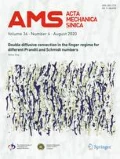Abstract
In this paper, the two-lane traffic are studied by using the lane-changing rules in the car-following models. The simulation show that the frequent lane changing occurs when the lateral distance in car following activities is considered and it gives rise to oscillating waves. In contrast, if the lateral distance is not considered (or considered occasionally), the lane changing appears infrequently and soliton waves occurs. This implies that the stabilization mechanism no longer functions when the lane changing is permitted. Since the oscillating and soliton waves correspond to the unstable and metastable flow regimes, respectively, our study verifies that a phase transition may occur as a result of the lane changing.
Similar content being viewed by others
References
Chowdhury D., Santen L. and Schadschneider A. (2000). Statistical physics of vehicular traffic and some related system. Phys. Rep. 329: 199–329
Bando M., Hasebe K., Nakayama A., Shibata A. and Sugiyama Y. (1995). Dynamic model of traffic congestion and numerical simulation. Phys. Rev. E 51: 1035–1042
Kerner B.S. and Konhäuser P. (1993). Cluster effect in initial homogeneous traffic flow. Phys. Rev. E 48: R2335–R2338
Kurtze D.A. and Hong D.C. (1995). Traffic jams, granular flow and selection. Phys. Rev. E 52: 218–221
Komatsu T.S. and Sasa S. (1995). Kink solution charactering traffic. Phys. Rev. E 55: 5574–5582
Xue Y. (2002). Analysis of the stability and density waves for traffic flow. Chin. Phys. 11: 1128–1134
Nagatani T. (1999). Stability and enhancement of traffic flow by next-nearest-neighbor interaction. Phys. Rev. E 60: 6395–6401
Ge H.X., Dai S.Q., Dong L.Y. and Xue Y. (2004). Stabilization effect of traffic flow in an extended car-following model based on intelligent transportation system application. Phys. Rev. E 70: 066134
Nagel K., Wolf D.E., Wagner P. and Simon P. (1998). Two-lane traffic rules for cellular automata: a systematic approach. Phys. Rev. E 58: 1425–1437
Knospe W., Santen L., Schadschneider A. and Schreckenberg M. (2002). A realistic two-lane traffic model for highway. J.~Phys. A 35: 3369–3388
Huang D.W. (2002). Lane-changing behavior on highways. Phys. Rev. E 66: 026124
Knospe, W., Santen, L., Schadschneider, A., Schreckenberg, M.: Optimization potential of a real highway network: an empirical study. Cond-mat/0204252 (2002)
Belitsky V., Krug J., Neves E.J. and Schütz G.M. (2001). A cellular automaton model for two-lane traffic. J. Stat. Phys. 103: 945–971
Fouladvand M.E. (2000). Reaction-diffusion models describing a two-lane traffic flow. Phys. Rev. E 62: 5940–5947
Daganzo C.F. (1997). A continuum theory of traffic dynamics for freeways with special lanes. Transport. Res. B 31: 83–102
Daganzo C.F., Lin W.H., Del Castillo and J.M. (1997). A simple physical principle for the simulation of freeways with special lanes and priority vehicles. Transport. Res. B 31: 103–125
Holland E.N. and Woods A.W. (1997). A continuum model for the dispersion of traffic on two-lane roads. Transport. Res. B 31: 473–485
Lighthill M.J. and Whitham G.B. (1955). On kinematic waves: a theory of traffic flow on long crowded roads. Proc. R. Soc. Lond. Ser. A 229: 317–345
Richards P.I. (1956). Shock waves on the highway. Oper. Res. 4: 42–51
Sasoh and A. (2002). Impact of unsteady disturbance on multi-lane traffic flow. J. Phys. Soc. Jpn. 71: 989–996
Davis L.C. (2004). Multilane simulations of traffic phases. Phys. Rev. E 69: 016108
Kurata S. and Nagatani T. (2003). Spatio-temporal dynamics of jams in two-lane traffic flow with a blockage. Physica A 318: 537–550
Nagai R., Nagatani T. and Taniguchi N. (2005). Traffic states and jamming transitions induced by a bus in two-lane traffic flow. Physica A 350: 548–562
Gipps P.G. (1986). A model for the lane-changing decisions. Transport. Res. B 20: 403–414
Tang X.W., Zhang C.S. and Lu K.S. (2004). Traffic Flow and Flow (in Chinese). Zhejiang University Press, Hangzhou
Zou Z.J. and Yang D.Y. (2002). Lane changing model for micro traffic simulation (in Chinese). China J. Highway Transport. 15: 105–108
Zou Z.J. and Yang D.Y. (2001). Pure-micro car-following model for traffic simulation system (in Chinese). J. Tongji Univ. 29: 898–901
Tang T.Q. and Huang H.J. (2004). Continuum models fro freeways with two lanes and numerical tests. Chin. Sci. Bull. 49: 2097–2104
Huang H.J., Tang T.Q. and Gao Z.Y. (2006). Continuum modeling for two-lane traffic flow. Acta Mech. Sinica 22: 132–137
Tang T.Q., Huang H.J. and Gao Z.Y. (2005). Stability of the car-following model on two lanes. Phys. Rev. E 72: 066124
Nagatani T. (1994). Traffic jam and shock formation in stochastic traffic-flow model of a two-lane roadway. J. Phys. Soc. Jpn. 63: 52–58
Nagatani T. (1994). Dynamical jamming transition induced by a car accident in traffic-flow model of a two-lane roadway. Physica A 202: 449–458
Author information
Authors and Affiliations
Corresponding author
Additional information
The project supported by the National Natural Science Foundation of China (70521001, 10404025, 10532060), the National Basic Research Program of China (2006CB705503) and the Research Grants Council of the Hong Kong Special Administrative Region (HKU7031/02E, HKU7187/05E).
The English text was polished by Boyi Wang.
Rights and permissions
About this article
Cite this article
Tang, T., Huang, H., Wong, S.C. et al. Lane changing analysis for two-lane traffic flow. Acta Mech Sin 23, 49–54 (2007). https://doi.org/10.1007/s10409-007-0054-9
Received:
Revised:
Accepted:
Published:
Issue Date:
DOI: https://doi.org/10.1007/s10409-007-0054-9




